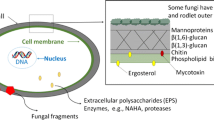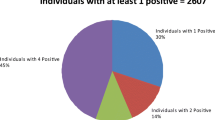Abstract
Fungal exposure is hypothesized (controversially) to contribute to asthma development and to trigger symptoms in patients with asthma. The ubiquity of environmental fungal exposure makes a careful review of evidence essential. Evidence that exposure to high concentrations of fungal spores, antigens, or metabolites is associated with asthma development is limited. However, because mechanisms of asthma genesis are poorly understood, so too are the mechanisms of this potential association. This association is not proof of causality. Stronger evidence supports the hypothesis that fungal exposure triggers symptoms in asthmatic individuals. Proposed mechanisms have been tested and correlations between exposure and symptoms demonstrated. Though some correlations remain speculative, controlled studies could test such hypotheses. Because asthma is common and fungal exposure is ubiquitous, it is surprising that asthmatics don’t have more symptoms when exposed to fungi. Fortunately, symptoms are dose dependent, creating an opportunity to develop clinically effective interventions. Given the right guidance, even patients with severe asthma can create healthy indoor environments.
Similar content being viewed by others
References and Recommended Reading
Alexopoulos CJ, Mims CW, Blackwell M: Introductory Mycology, edn 4. New York: John Wiley & Sons; 1996.
Ryan KJ, Ray CG: Sherris Medical Microbiology, edn 4. New York: McGraw-Hill; 2004:633–638.
Shelton B, Kirkland KH, Flanders WD, et al.: Profiles of airborne fungi in buildings and outdoor environments in the United States. Appl Environ Microbiol 2002, 68:1743–1753.
Green B, Tovey ER, Sercombe JK, et al.: Airborne fungal fragments and allergenicity. Med Mycol 2006, 44(Suppl 1):S245–S255.
Portnoy J, Flappan S, Barnes C: A procedure for evaluation of the indoor environment. Aerobiologia 2001, 17:43–48.
Salo PM, Arbes SJ Jr, Sever M, et al.: Dustborne Alternaria alternata antigens in US homes: results from the National Survey of Lead and Allergens in Housing. J Allergy Clin Immunol 2005, 116:623–629.
Simons E: Ancestors of Allergy. New York: Global Medical Communications; 1994:146.
Denis O, van den Brûle S, Heymans J, et al.: Chronic intranasal administration of mould spores or extracts to unsensitized mice leads to lung allergic inflammation, hyper-reactivity and remodelling. Immunology 2007, 122:268–278.
Garrett M, Rayment PR, Hooper MA, et al.: Indoor airborne fungal spores, house dampness and associations with environmental factors and respiratory health in children. Clin Exp Allergy 1998, 28:459–467.
Gallup J, Kozak P, Cummins L, et al.: Indoor mold spore exposure: characteristics of 127 homes in Southern California with endogenous mold problems. EXS 1987, 51:139–142.
Stark P, Burge HA, Ryan LM, et al.: Fungal levels in the home and lower respiratory tract illnesses in the first year of life. Am J Respir Crit Care Med 2003, 168:232–237.
O’Driscoll BR, Hopkinson LC, Denning DW: Mold sensitization is common amongst patients with severe asthma requiring multiple hospital admissions. BMC Pulm Med 2005, 5:4.
Chiu LL, Perng DW, Yu CH, et al.: Mold allergen, pen C 13, induces IL-8 expression in human airway epithelial cells by activating protease-activated receptor 1 and 2. J Immunol 2007, 178:5237–5244.
Shen HD, Chou H, Tam MF, et al.: Molecular and immunological characterization of Pen ch 18, the vacuolar serine protease major allergen of Penicillium chrysogenum. Allergy 2003, 58:993–1002.
Chapman M, Wünschmann S, Pomés A: Proteases as th2 adjuvants. Curr Allergy Asthma Rep 2007, 7:363–367.
Alarie Y, Schaper M, Nielsen GD, Abraham MH: Estimating the sensory irritating potency of airborne nonreactive volatile organic chemicals and their mixtures. SAR QSAR Environ Res 1996, 5:151–165.
Fischer G, Dott W: Relevance of airborne fungi and their secondary metabolites for environmental, occupational and indoor hygiene. Arch Microbiol 2003, 179:75–82.
Schnurer J: Comparison of methods for estimating the biomass of three food-borne fungi with different growth patterns. Appl Environ Microbiol 1993, 59:552–555.
Rylander R, Lin R: (1—>3)-beta-D-glucan—relationship to indoor air-related symptoms, allergy and asthma. Toxicology 2000, 152:47–52.
Rylander R, Norrhall M, Engdahl U, et al.: Airways inflammation, atopy, and (1—>3)-beta-D-glucan exposures in two schools. Am J Respir Crit Care Med 1998, 158:1685–1687.
Rylander R, Holt P: (1—>3)-beta-D-glucan and endotoxin modulate immune response to inhaled allergen. Mediators Inflamm 1998, 7:105–110.
el-Maghraby OM, Bean GA, Jarvis BB, Aboul-Nasr MB: Macrocyclic trichothecenes produced by Stachybotrrys isolated from Egypt and eastern Europe. Mycopathologia 1991, 113:109–115.
Hanelt M, Gareis M, Kollarczik B: Cytotoxicity of mycotoxins evaluated by the MTT-cell culture assay. Mycopathologia 1994, 128:167–174.
Johanning E: Bioaerosols, Fungi and Mycotoxins: Health Effects, Assessment, Prevention and Control. Albany, NY: Eastern New York Occupational and Environmental Health Center (OEHC); 1999.
Douwes J, Pearce N: Invited commentary: is indoor mold exposure a risk factor for asthma? Am J Epidemiol 2003, 158:203–206.
Brunekreef B, Dockery DW, Speizer FE, et al.: Home dampness and respiratory morbidity in children. Am Rev Respir Dis 1989, 140:1363–1367.
Kilpeläinen M, Terho EO, Helenius H, Koskenvuo M: Home dampness, current allergic diseases, and respiratory infections among young adults. Thorax 2001, 56:462–467.
Verhoeff A, Burge H: Health risk assessment of fungi in home environments. Ann Allergy Asthma Immunol 1997, 78:544–554.
Verhoeff AP, van Strien RT, van Wijnen JH, et al.: Damp housing and childhood respiratory symptoms: the role of sensitization to dust mites and molds. Am J Epidemiol 1995, 141:103–110.
Zureik M, Neukirch C, Leynaert B, et al.: Sensitisation to airborne moulds and severity of asthma: cross sectional study from European Community respiratory health survey. BMJ 2002, 325:411.
Institute of Medicine: Damp Indoor Spaces and Health. Washington, DC: National Academy of Sciences, Board on Health Promotion and Disease Prevention, National Academies Press; 2004.
Gergen P, Turkeltaub P: The association of individual allergen reactivity with respiratory disease in a national sample: data from the second National Health and Nutrition Examination Survey, 1976–80 (NHANES II). J Allergy Clin Immunol 1992, 90(4 Pt 1):579–588.
O’Connor G, Walter M, Mitchell H, et al.: Airborne fungi in the homes of children with asthma in low-income urban communities: the Inner-City Asthma Study. J Allergy Clin Immunol 2004, 114:599–606.
Jaakkola M, Ieromnimon A, Jaakkola J: Are atopy and specific IgE to mites and molds important for adult asthma? J Allergy Clin Immunol 2006, 117:642–648.
Koskinen O, Husman TM, Meklin TM, et al.: The relationship between moisture or mould observations in houses and the state of health of their occupants. Eur Respir J 1999, 14:1363–1367.
Clark N, Brown RW, Parker E, et al.: Childhood asthma. Environ Health Perspect 1999, 107(Suppl 3):421–429.
Halonen M, Stern DA, Wright AL, et al.: Alternaria as a major allergen for asthma in children raised in a desert environment. Am J Respir Crit Care Med 1997, 155:1356–1361.
Niedoszytko M, Chelmiska M, Jassem E, Czestochowska E: Association between sensitization to Aureobasidium pullulans (Pullularia sp) and severity of asthma. Ann Allergy Asthma Immunol 2007, 98:153–156.
Zock J, Jarvis D, Luczynska C, et al.: Housing characteristics, reported mold exposure, and asthma in the European Community Respiratory Health Survey. J Allergy Clin Immunol 2002, 110:285–292.
Newson R, Strachan D, Corden J, et al.: Fungal and other spore counts as predictors of admissions for asthma in the Trent region. Occup Environ Med 2000, 57:786–792.
Targonski P, Persky V, Ramekrishnan V: Effect of environmental molds on risk of death from asthma during the pollen season. J Allergy Clin Immunol 1995, 95(5 Pt 1):955–961.
Salvaggio J, Aukrust L: Mold induced asthma. J Allergy Clin Immunol 1981, 68:327–346.
Salvaggio J, Seabury J, Schoenhardt E: New Orleans asthma. V. Relationship between Charity Hospital asthma admission rates, semiquantitative pollen and fungal spore counts, and total particulate aerometric sampling data. J Allergy Clin Immunol 1971, 48:96–114.
O’Hollaren M, Yunginger JW, Offord KP, et al.: Exposure to an aeroallergen as a possible precipitating factor in respiratory arrest in young patients with asthma. N Engl J Med 1991 324:359–363.
Pulimood TB, Corden JM, Bryden C, et al.: Epidemic asthma and the role of the mold Alternaria alternata. J Allergy Clin Immunol, 2007, 120:610–617.
Portnoy J, Brothers D, Pacheco F, et al.: A double monoclonal antibody assay for the Alternaria Allergen, Alt a1. Ann Allergy Asthma Immunol 1998, 81:59–64.
Achatz G, Oberkofler H, Lechenauer E, et al.: Molecular cloning of major and minor allergens of Alternaria alternata and Caldosporium herbarium. Mol Immunol 1995, 32:213–227.
Agarwal MK, Jones RT, Yunginger JW: Shared allergen and antigenic determinants in Alternaria and Stemphylium extracts. J Allergy Clin Immunol 1982, 70:437–444.
Belanger K, Beckett W, Triche E, et al.: Symptoms of wheeze and persistent cough in the first year of life: associations with indoor allergens, air contaminants, and maternal history of asthma. Am J Epidemiol 2003, 158:195–202.
Gent J, Ren P, Belanger K, et al.: Levels of household mold associated with respiratory symptoms in the first year of life in a cohort at risk for asthma. Environ Health Perspect 2002, 110:A781–A786.
Eggleston P: Control of environmental allergens as a therapeutic approach. Immunol Allergy Clin North Am 2003, 23:533–547, viii–ix.
Kercsmar C, Dearborn DG, Schluchter M, et al.: Reduction in asthma morbidity in children as a result of home remediation aimed at moisture sources. Environ Health Perspect 2006, 114:1574–1580.
Morgan W, Crain EF, Gruchalla RS, et al.: Results of a home-based environmental intervention among urban children with asthma. N Engl J Med 2004, 351:1068–1080.
Matsui E, Kagey-Sobotka A, Chichester K, et al.: Allergic potency of recombinant Fel d 1 is reduced by low concentrations of chlorine bleach. J Allergy Clin Immunol 2003, 111:396–401.
Nickmilder M, Carbonnelle S, Bernard A: House cleaning with chlorine bleach and the risks of allergic and respiratory diseases in children. Pediatr Allergy Immunol 2007, 18:27–35.
Barnes CS, Portnoy JM, Kennedy K: The impact of home cleaning on quality of life for homes with asthmatic children. Allergy Asthma Proceedings 2007, In press.
Author information
Authors and Affiliations
Corresponding author
Rights and permissions
About this article
Cite this article
Portnoy, J.M., Barnes, C.S. & Kennedy, K. Importance of mold allergy in asthma. Curr Allergy Asthma Rep 8, 71–78 (2008). https://doi.org/10.1007/s11882-008-0013-y
Published:
Issue Date:
DOI: https://doi.org/10.1007/s11882-008-0013-y




